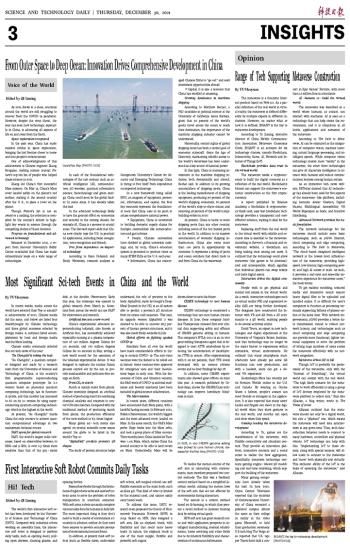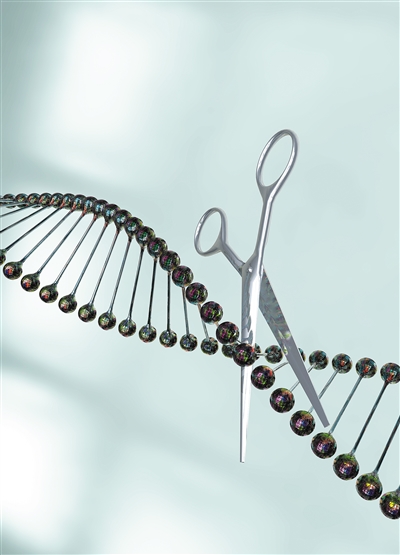
 |
| In 2021, in vivo CRISPR genome editing was proved to cure human chronic diseases for the first time. (PHOTO: VCG) |
In recent weeks, media across the world have selected their Top 10 scientific achievements of 2021. Chinese media did the same, and below are listed four breakthroughs by Chinese technology, and three global successes selected by foreign media. A common listed accomplishment by local and foreign media was the Mars landing.
Chinese media commonly selected four sci-tech news of the year:
"Zu Chongzhi"is taking the lead
"Zu Chongzhi", a quantum computer designed and made by a research team from the University of Science and Technology of China, is the country's first programmable superconducting quantum computer prototype. Its 2.0 version based on photonics quantum computing technology, has 62 functional qubits, and this number has increased to 66 on its 2.1 version by using superconducting quantum computing technology, which is the highest in the world.
At present, "Zu Chongzhi" marks China the only country to achieve quantum computational advantage in two mainstream technical routes.
FAST opens for global research
FAST, the world's largest radio telescope, based on observables between 70 MHz and 3 GHz, is over 2.5 times more sensitive than that of the 305 -meter dish at the Arecibo Observatory. Early this year, the telescope was opened to global research from March 31. Scientists from across the world can use FAST for observation and research.
Artificial Sun sets a new record
China's experimental advanced superconducting tokamak, also known as Artificial Sun, has successfully achieved repeatable running at a plasma temperature of 120 million degrees Celsius for 101 seconds, and 160 million degrees Celsius for 20 seconds in May, setting a new world record for the operation of the tokamak experimental device. It was designed to replicate the nuclear fusion process carried out by the sun to provide inexhaustible and pollution-free energy on Earth.
From CO_2 to starch
Starch is mainly made from plants. Chinese scientists designed an artificial method of producing starch by combining chemical catalysts and enzymes to convert CO2 into starches. Compared with the traditional method of producing starch from plants, the production efficiency of the new method is 8.5 times higher.
Many global sci -tech media also agreed on several scientific news issues around the globe to be listed in the world's Top 10:
"AlphaFold" predicts protein's 3D shapes
The study of protein structure helps understand the role of proteins in the body. AlphaFold, made by Google's DeepMind (located in the UK), is an AI system able to predict a protein's 3D structure from its amino acid sequence. This year, its upgrade version AlphaFold 2 was claimed to be able to uncover 98.5 percent of human protein structures, and it was also made freely available in July.
Global efforts on fighting against COVID-19
Scientists from all over the world have made commendable efforts in trying to contain COVID -19. The anti-virus vaccines were the fastest to be rolled out in history. Some vaccines were approved for emergency uses and their inoculations began in early 2021. With the discoveries of Delta and Omicron variants, the R&D work of COVID-19 antiviral medicines and booster injections have been included in global science collaboration.
The Mars mission
In recent years, different countries have announced their Mars plans, with a handful having success. In February 2021, NASA's Perseverance, the world's biggest and the most advanced rover, landed on Mars. In the same month, the UAE's Mars probe Hope broke into the Mars orbit, and took a group photo of Mars auroras. Three months later, China landed its Tianwen-1 on Mars, which makes China the second country to be able to land rovers on Mars. Undoubtedly, Mars will be drawn closer to us in the future.
CRISPR technology to cure human disease
CRISPR technology is considered a technology that can cure human chronic diseases. In June, Gene company Intelliax Therapeutics released first-ever clinical data supporting safety and efficacy of CRISPR genome editing in humans. The company's NTLA-2001 is an in vivo gene-editing therapeutic agent that is designed to treat ATTR amyloidosis by reducing the concentration of transthyretin (TTR) in serum. After experimenting with it on six patients, their TTR levels decreased with no serious adverse events and no liver findings by day 28.
In addition, some CRISPR experiments also showed great effects on mice this year. A research published by Cedars-Sinai, shows the CRISPR/Cas9 technology can improve hereditary blindness in mice.


 Next
Next




